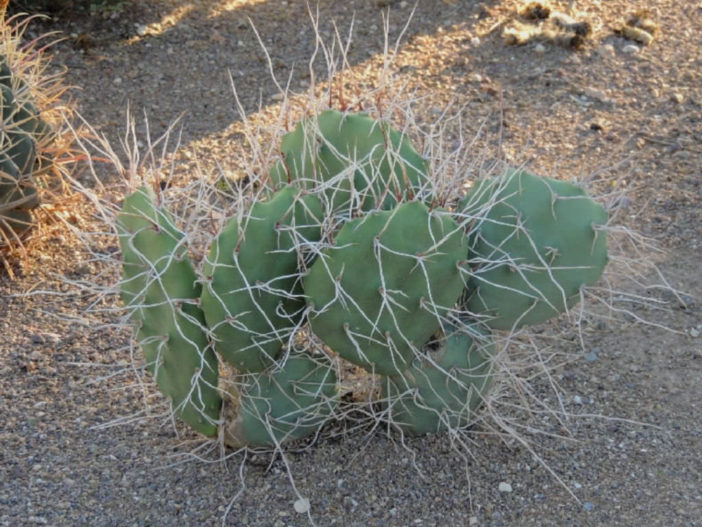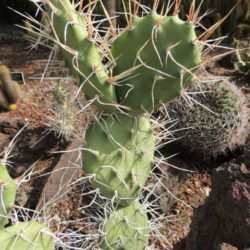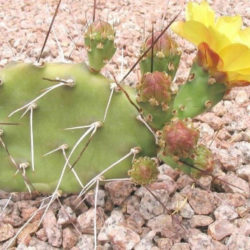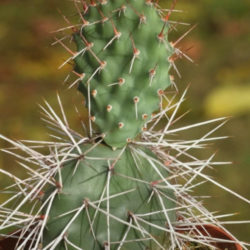Scientific Name
Opuntia sulphurea Gillies ex Salm-Dyck
Common Name(s)
Prickly Pear Cactus
Synonym(s)
Cactus sericeus, Cactus sulphureus, Opuntia albisetosa, Opuntia coerulea, Opuntia sericea, Opuntia sulphurea var. major, Opuntia sulphurea var. pallidior, Opuntia sulphurea var. sulphurea, Platyopuntia sulphurea
Scientific Classification
Family: Cactaceae
Subfamily: Opuntioideae
Tribe: Opuntieae
Genus: Opuntia
Description
Opuntia sulphurea is a low-growing cactus composed of many elliptic to ovoid pads with clusters of needle-like spines. It tends to stay low to the ground and grow wider rather than taller, forming clumps that can reach up to 16 inches (40 cm) in height and 6.6 feet (2 m) in diameter. The pads are tuberculate, green, sometimes purplish, and measure up to 12 inches (30 cm) long and 5.2 inches (13 cm) wide. The small, white areoles exhibit atop protuberances, most bearing one to eight spines and yellowish-red to brown glochids. The spines have a pink or brown tinge when young turn ashy-gray or white, sometimes reddish-brown, and grow up to 0.4 inches (1 cm) long, often twisting as they mature.
The flowers are bright yellow, often with a paler center, reach up to 1.6 inches (4 cm) in length and 2.2 inches (5.5 cm) in diameter, and appear along the edges of the uppermost pads in spring. The fruits are yellow to red, barrel-shaped, about 1.4 inches (3.5 cm) long, with a divot on the top left when the dried remains of the flower drop away.
Origin
The native range of Opuntia sulphurea is mainly in Argentina, from the Mendoza province up to Juyjuy in the north and the Buenos Aires province to the west, and in parts of Chile, Paraguay, Bolivia, and Brazil.

Hardiness
USDA hardiness zones 9b to 11b: from 25 °F (−3.9 °C) to 50 °F (+10 °C).
How to Grow and Care
The large variety of species within the Opuntia genus means different plants may need slightly different care. All are desert cacti that need lots of sun, lots of light, and very little water. If you live in a hot, arid area, these plants can generally be planted outside, left alone, and enjoyed.
These cacti will grow just fine in a garden but can also be grown in pots. To repot, ensure the soil is dry, remove the pot, and remove the old soil. After treating any cuts with fungicide, place the cactus in a new pot and backfill it with potting soil. As with a new cutting, ensure not to water a newly repotting Prickly Pear briefly to avoid rotting its roots.
Opuntia can propagate either by cuttings or by seed. To propagate by cuttings, sever pads from a plant and let them dry to heal the wounds. Then, place the plants in dry soil and refrain from watering them until they begin to grow to avoid rotting them.
See more at How to Grow and Care for Opuntia.
Links
- Back to genus Opuntia
- Succupedia: Browse succulents by Scientific Name, Common Name, Genus, Family, USDA Hardiness Zone, Origin, or cacti by Genus
Photo Gallery
Click on a photo to see a larger version.


